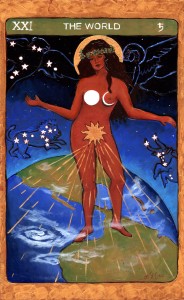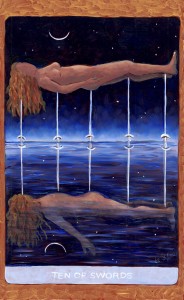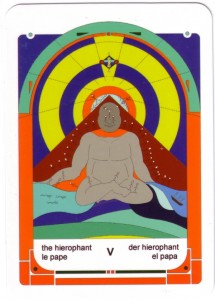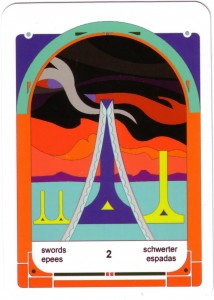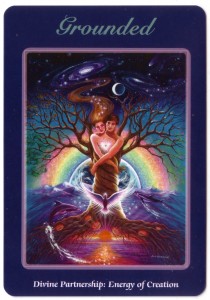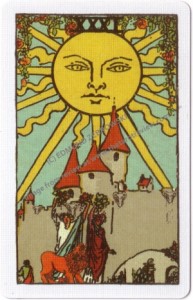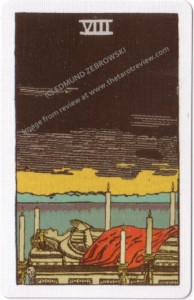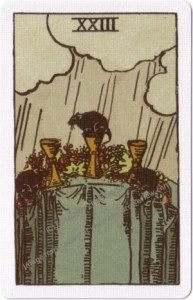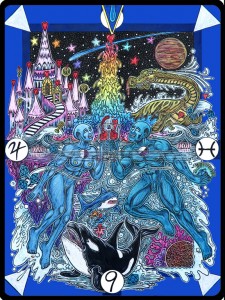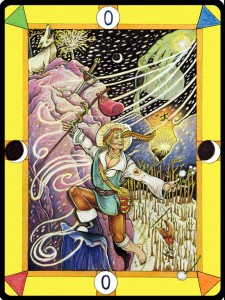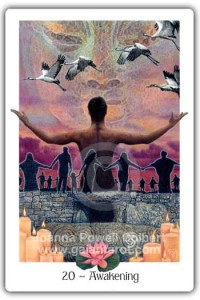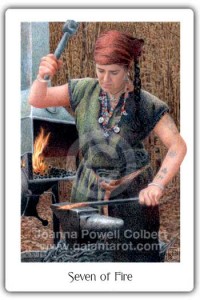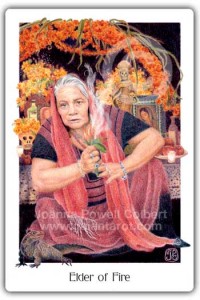Tarot de St. Croix, by Lisa de St. Croix
Posted by: TheReviewer on: March 7, 2012
- In: Featured | Sneak Peaks
- 1 Comment
A sneak peek at the in-progress Tarot de St. Croix, and the artist’s journey to the creative process.
My tarot journey began when I was a child. My mother visited a Portuguese tarot reader in Johannesburg who told her that within a year she would be divorced, marry a foreigner, move away from South Africa, live by the sea in a distant land and that her youngest child would become famous. Well, indeed all these things occurred, though I am still working on that last prophecy. My mother bought a Marseilles deck at that time and I remember being awed by the power of the images.
About ten years ago I began to study the tarot. I remembered the old Marseilles deck which my mother had given me and I so carelessly lent to an art school friend and had lost. Speaking to a mutual friend I talked about the deck and she gasped. Just that week she had been helping our friend move and had come across the very same deck. Within a few weeks the deck came back to me. I began to use it to communicate with my deceased mother and I was startled at how it spoke to me in the same way she would.
A couple of years ago I did a shamanic journey on the Winter Solstice, in which I traveled to the upper world to meet my spirit guide Isis. She told me to paint the tarot. Shortly after that I began working on the Tarot de St. Croix. The creative process for each card begins when I shuffle the cards and pull one at random to paint. Every time the card speaks to me directly about my current situation, synchronicities happen frequently and I receive many profound lessons. I have entered the archetypal world and am experiencing both the personal and universal meaning of each card.
I feel guided by a higher power and have learnt to trust the images that come to me even when I don’t fully understand them. At times I use my personal life, relationships and experiences as imagery but I also use other sources. Sometimes I “journey†for a vision using the classic shamanic technique of the heart beat drum. I also use current affairs such as the Occupy protestors in my Five of Wands. I use my art school training in the old masters technique of layering oil glazes over a Venetian red background. This gives a vibrant luminosity to the colors. I use Renaissance gold on the border which gives a sumptuous rich texture.
My intention in creating this deck is to bring new levels of meaning to the classic Minor and Major Arcana of the Tarot. I want each card to first evoke a feeling in the viewer – a gestalt. A closer look then reveals many layers of symbols and their meanings.
You can view my cards on my website www.lisadestcroix
The World is the final card of the archetypal journey of the soul. This card represents wholeness and as Jung said “…indissoluble communion with the world at large.†The self becomes numinous containing all the elements, all creation and the entire cosmos. In painting The World I was inspired by the alchemical engravings of Anima Mundi – the Soul of the World. They saw the world as a loving, spiritual being.
In The World card Anima Mundi is surrounded by the constellations of Leo, Aquila and Taurus. The angel represents the great mystery. Anima Mundi stands with one foot on earth, one on water with her head in the stars surrounded by the wreath of triumph. She is a woman who might come from any continent. She represents the origin of life with the sun radiating from her womb and her breasts are the full and new moon.
I grew up in South Africa and even though I moved to New York after I finished high school to attend art school and made the United States my home, I have never lost my love for Africa. The rich colors of the cloth, the exotic fruits, the brilliant sky and lush vegetation and the beauty of the people vividly remain with me.
The Queen of Pentacles is the sensuous embodiment of abundance. The Queen of Sheba inspired this Queen of Pentacles. Ripe fruit, fragrant flowers and a gold palanquin represent the riches from the Earth. Her bearers are two virile young men who adore their beautiful, generous Queen. In the fields behind her grows the sacred herb of Ethiopia and its golden buds are plentifully stacked on a gold platter.
The Ten of Swords represents both the expression of self-sabotage by worries, victim hood and powerlessness as well as the promise of a transformation into a new way of seeing challenges. That what does not kill us makes us stronger. One figure floats face down, drowning in despair, but it is a distorted reflection of herself who is also able to rise above the sharp lessons. The rising figure faces a new moon promising a new beginning, while way below the sinking figure the old moon fades.
Traditionally this is a pretty dismal card, it is important for me to find positive ways of depicting the meaning without losing the teachings of difficult cards.
TheReviewer’s Note: Lisa has been sharing her creative journey through the Tarot with the Tarot Professionals Facebook group. With each new card that she pulls from her deck to paint next, she discusses the themes, symbolism and messages of the card with the Tarot Professionals Facebook community. It’s been interesting to see the process in action, and to be part of the creation of such a unique, vibrant and beautiful deck. I, for one, can’t wait to see it completed and released!
Tarot in the Land of Mystereum
Posted by: WizzyWizzard on: March 5, 2012
- In: Deck Reviews | Featured
- Comments Off on Tarot in the Land of Mystereum
As a fan of more traditional and “magical” style Tarot decks such as the Waite-Smith and Thoth deck, this particular deck, Tarot in the Land of Mystereum by Jordan Hoggard (Schiffer Books, 2011) is a bit of a deviation for me.
This deck and book boxset is very well presented in an attractive, long cigar-type box. The lid of the box is held closed with magnets and opens upwards to rest on ribbon hinges which is a nice touch.
The side of the box describes it as:
A wonderful and evocative imagination primer for the young at heart!
Takes your imagination to new heights and depths.
An upbeat expression of Tarot to develop your ideas and imagination.
So let us see if it indeed lives up to those lofty claims.
On opening the box my first impression is that the cards are quite large, 9cm by 12cm. They are made from good quality laminated card stock, but unless you have quite large hands you may struggle shuffling this deck, as I did.
The deck contains 78 cards divided in the usual way, 22 Majors, 16 Court Cards and 40 Pip cards. Each card has the name of the card in English, French, Spanish and German.
All of the cards are illustrated in a very bright and vivid color scheme and they all contain the same archway style border, which actually takes up quite a lot of the card itself.
The pictures are drawn in a cartoon style using a limited color palette, giving all the cards a similar yet different look to each other; it reminds me somewhat of the Liber T deck.
The images on the Major Arcana are non-traditional, yet very imaginative, abstract and somewhat psychedelic. Each picture contains lots of details, pictures within pictures, symbols and characters. This – along with the vivid color scheme – can make you feel like you have already stepped through the looking glass.
For example, The Hierophant resembles a grey Buddha-type character sitting in a green landscape. He is in front of a large pyramid behind which is a blue and yellow sun mandala. In another card, the body of the Hierophant himself has lots of tiny stickmen walking all over him. Three other stickmen float alongside in a rowing boat … non-traditional, slightly bizarre, yet appealing to the eye.
The Justice card has some traditional imagery yet with a difference. There is a sword in the centre of the card forming the main structure of the scales, two disembodied hands rest under the scales on which a heart is being weighed against a feather.
Two other Major Arcana Cards that stand out immediately are The Hermit and Death as they have a strange connection in this deck.
The Hermit contains some familiar elements, a cloaked figure with a staff and a lantern. There is an image of the moon on one side of the card with the sun on the other. The Hermit seems to have some kind of x-ray vision beaming from his eyes and his cloak – far from being the usual grey – is a bright vibrant red!
The Death card shows a white silhouetted figure riding a white horse, as you may expect, but this particular Death carries a double ended scythe, and within each blade (top and bottom) is the image of the Hermit card, the scythe blade becoming the arched border from the Hermit card, with his cloak blending seamlessly onto the horse. This gives a strange yet pleasing imagery.
The Minor Arcana continue in the style of the Majors yet are maybe slightly less abstract, there are indications of meanings on some of the cards – the 10 of Cups shows an image of two hands held together and a picture of a family house, other Minor cards have minimal symbolism, for example a lot of the Sword cards have the same image with just a differing number of swords in the foreground .
The Court Cards each contain the image of a person as expected yet some of them contain other images from the Major Arcana; The Page of Cups has the image of The Hanged Man while the Page of Pentacles has images of the Magician, the Hierophant and the Chariot hidden within.
Does infinity have a middle?
Is infinity in each of us?
Is infinity in both each of us and all of us?
These are some of the questions given for you to ponder in the introduction to the book. The book is written in a light-hearted, almost childish style at times. The learning method within is, according to the box, “a character driven approach giving each tarot card a personality linked to youâ€.
Instead of having a list of keywords to learn, this book encourages you to make a personal connection with each card. Each card is introduced one at a time starting with the Fool and working through all the Majors and then the Minors in order. You are encouraged to look at the cards and “breathe” them before reading the chapter for each individual card.
There is a brief description of what the card indicates and a black and white picture of the card. Then there is a statement from each card character itself – you are encouraged to read these out loud, also each card has a “gift†for you to encourage your imagination and creativity.
For the Devil we have statements such as:
The Devil in one way indicates the power of your expectations with focus rather than blind spots. The Devil is not “Satan”. The Devil here is Pan. He is half goat, nature god. Some call him Dionysus. Others call him Bacchus. Pleasure, and to happily let go in the wild, unbridled play is indicated.
After this initial description you are met by the card character himself, each one having his or her own distinct personality. The Devil introduces himself like this:
Huuuuurrrrroooo!!!!! How RRRRR UUUUU? I am not THAT devil. I am not Satan. I am a deity more like Pan. I will hang back a little and let that settle in for you. Proceed when you feel ready.
As for the “giftsâ€, The Fool has three gifts; the first being “feel and remember natural and new directions you create as you move and evolve your ideas with imagination and creativity” .
This seems to be an effective way to get you actually thinking and using your own ideas to evoke meanings from the cards and I really like this approach. It gives you a real feeling for the card so much more than just listing possible meanings and keywords. It creates an image in your mind and enables you to make a more personal connection with the card as a living entity rather than just a printed picture.
Having expected to not like this deck I find that the more time I spend with it the more I am drawn into both the imagery and the learning method. It is a great intuitive deck with very colorful artwork. There is a lot of movement within the pictures so you feel like you could just step into some of the strange scenes. The Majors are particularly attractive and evocative.
This is a great deck for beginners with no previous knowledge of Tarot meanings clogging up their brains, yet it is also a good tool for more intermediate or professional readers who want to get back to feeling the cards more rather than working from keywords or past learning.
This would perhaps also be an ideal deck to introduce children to the subject.
I will continue to work with this deck and the accompanying book. My only criticism is the size of the deck itself; it might be a struggle in actual readings. For study and meditation on the cards I think it has great potential.
You can buy the deck at Amazon and the main site for the deck is Jordan Hoggard: Tarot in the Land of Mystereum.
Wizzy Wizzard
Celebration of Love Oracle Cards
Posted by: Amilace on: March 3, 2012
- In: Deck Reviews | Featured
- Comments Off on Celebration of Love Oracle Cards
Celebration of Love Oracle Cards were my first exposure to Schiffer decks, and I was quite impressed with the quality of the packaging and presentation. The deck is encased in an illustrated, well-constructed, and sturdy box that can be re-used for storage and protection. The cards themselves are large enough, 5.3″ x 3.3″ x 1.5,” to prominently display the detailed artwork and oracle message on each. They were a little large for my smallish hands, but anyone used to traditional tarot decks will find them easy to shuffle and work with. The card stock is sturdy and they are laminated.
The box contains 60 cards and a companion booklet. The artist and author, Eva M. Sakmar-Sullivan, begins the booklet with her intention for the deck’s use:
It is my most sincerest intention that these Celebration in Love oracle cards serve your Highest Good and that they spark your intuition and connection with the Divine that is within you always.
 Apart from the arbitrary capitalization of certain words, I appreciated the sincerity and the heartfelt effort that went into her creation of this deck. At first glance, the art, though very well done, seemed somewhat predictably “new age†with its proliferation of rainbows, angels, fairies, dolphins and doves and unicorns. Not that there’s anything wrong with those things, but as someone not drawn to that genre I hoped the cards would reveal more substance than I initially expected. Wanting to know more about the author, I visited her professional website: “Dreams of Stardolphin: The Visionary Art of Eva M. Sakmar-Sullivan.â€Â I was specifically curious why so many of the cards featured dolphins and was delighted to read the author’s personal experience of overcoming her own fears to swim with dolphins. It is an inspiring story and after learning a little more about her background, I began to feel more of a connection with the author and her cards. She is a professionally trained artist and her attention to detail in her work is considerable. The images, though rich and colorful, are also serene and muted. They appear well-suited to meditative work. In fact, one of the suggested exercises in the booklet gives instructions how to meditate using the cards.
The booklet states that, based on the law of attraction, one “will always choose the card that is in vibrational harmony with the answer you seek to your question or what you most need to know at this moment in time.†It also describes the intended use of the cards for daily introspection: “Working with these cards on a daily basis will eventually help you to resonate from a higher energy and have a greater positive impact on your life and those around you.â€Â It then helpfully gives instruction for use, describing how to cleanse and bless the deck and then it suggests exercises for one-card daily guidance, a three-card past-present-future spread, and a meditation exercise. Most of the booklet is an alphabetical index of meanings for each card, each with a “Special Message†that is meant to serve as an action-based directive, something one can practically do to put the card’s message to use. I found the inclusion of these special messages particularly encouraging because I personally appreciate grounding spiritual revelation in earthly action in order to manifest a measurable progress of self growth.
With booklet in hand, I shuffled the cards and fanned them out, simply asking for a significant message for myself today. The card chosen turned out to be the one entitled “Grounded.â€Â Isn’t that ironic? I felt as if the deck was acknowledging my skepticism with regard to its “fluffy†new age appearance and assuring me that it was, indeed, grounded in solid, useful concepts. This card also happens to be the image chosen for the card backs, indicating to me that the entire deck was “grounded†in this way. The booklet’s message for this card:
This image celebrates the Divinely balanced union of male/female energy receiving the Sacred download of life force from the Creator, All That Is. It calls us to joyfully allow all our creations and manifestations their birth from this holy state of being.Â
           Begin a new project or something you need to do, but are procrastinating. Start it first by centering yourself and call forth the Sacred download from the Creator. See it as a balanced fusion of male/female energy and bring it through yourself and into your hands that hold the energetic “embryo†representing this project. Let it go…then begin.
           Special Message: There is something that you need to address. There is procrastination surrounding an issue or project you need to break through. You are being inspired to move through the blockage and create. Your action is long over due.
Well, that was timely. There really is something significant that I have been procrastinating and that I need to get on with. Despite snickering at the term, “Sacred download†(in the text for the card above) I felt the message was on the mark and useful for me today. Contrary to my initial impression of this oracle deck, Celebration of Love is much more than airy-fairy, ethereal conceptual art but rather can be an entirely useful tool for daily guidance and growth.
Amilace
Celebration of Love Oracle Cards
Author/Artist: Eva M. Sakmar-Sullivan
Published by Schiffer Books, 2009
ISBN #978-0-7643-3183-1
Available on Amazon at:Â Celebration of Love: Oracle Cards [With 60 Oracle Cards]
Pixie’s Astounding Lenormand Deck
Posted by: PippyDecker on: March 3, 2012
- In: Deck Reviews | Featured
- Comments Off on Pixie’s Astounding Lenormand Deck
A version of the Lenormand executed in the style of Pamela Colman-Smith? This creation of Edmund Zebrowski is a gift bestowed upon the reader, with the perfect synergy of Pamela Colman Smith (Pixie), A.E Waite and Mlle. Lenormand. This unique deck, so elegantly packaged in faux-vintage newspaper, captivates one’s imagination from the outset; the senses are awoken as if by pixie magic from slumber to daylight. This is a new vintage, carefully designed – perhaps even decanted from the imagination of a bygone age.
Once one has carefully undressed the deck, the first thing that strikes you about the box is the lesser-known artwork of Pamela Colman Smith which she created for the Polish Victims Relief Fund. This immediately gives us a sense of displacement because we are familiar with the artwork style, but do not immediately recognize the image. This thoughtful design prepares us for the partial familiarity we will experience within the deck itself.
The deck comes with the companion LWB, ‘The Key to the Lenormand’, the myth behind the making, which weaves a narrative mystery within the inception of his creation, the story is told of the miraculous manifestation of the images ‘hidden within the art of Pamela Colman Smith’ and how they were imparted. This makes the LWB a work of imagination in itself and is a refreshing take on the standard keywords or stock meanings.
Edmund has ingeniously taken common iconography from the PCS artwork and manipulated it (using Photoshop) into the format of the Lenormand deck.  This really does work; it gives an extra dimension to the cards and has a comfy familiarity to it, and a rather friendly one at that. This deck is also imbued with the camaraderie energy which was around at its conception, arising in the company of friends as narrated in the LWB. The sense of play shines through the images throughout the deck – there is not a single dud card.
There are 36 cards in the deck as in the fashion of the Lenormand. The cardstock is good, laminated, with a reddened version of the speckled back of the Pamela BÂ used for the back of the cards.
The images are constructed from a range of Pixie’s artwork and cards. Our first example, Card 31, that of the Sun in the Lenormand, shows the use of stock symbols from the Waite-Smith deck combining the Sun, The Four of Wands and Strength. In comparison, Card 27, The Letter, uses the reversed image of Pixie’s portrait of Ellen Terry (1902).
This deck also provides an extra and unexpected insight into the 1910 Waite-Smith Tarot creation. As an example, in Pixie’s Astounding Mlle Lenormand, Edmund Zebrowski is beautifully aware that Pamela Colman-Smith drew inspiration for her Six of Swords from her earlier 1902 illustration of the “The Lady of the Scarlet Shoesâ€. This illustrated the last stanza of a poem by Alix Egerton. Here the figure is in repose and lit by a single candle. Edmund takes the image further and in Card 8, The Coffin, the lady is surrounded by six candles. This wonderfully evokes the original poem that Colman-Smith surely had in mind with the Six of Swords:
“In ancient chapel faraway
Among the sculptured dead,
There lies a lady wondrous fair,
A crown upon her head;
Though her marble form is as white as snow
Her shoes are poppy red .”
To compare Card 8, The Coffin, in Pixie’s Astounding Mlle Lenormand to that of the Lenormand Blue Owl, one is struck by how light one is compared to the foreboding darkness of the other. There is an enduring tranquillity in the Card 8 Coffin of Pixie’s astounding deck.
This deck develops the Lenormand tradition by providing a recognisable stepping stone to Tarot. It encourages you to be conversant equally with both forms of cartomancy. It would be nice to think that as a story-teller Pixie would look at this deck and see that her images have a life all of their own, leaping beyond her original telling into their own further adventures.
One further game to play with this deck is to identify the sources of every image, for example, where does the fox on Card 14 appear in Pixie’s work? I will certainly be using this deck as a teaching tool in future for the benefit of the Lenormand and RWS as well as a divination tool.
Edmund is also working on an innovative Lenormand de Marseilles deck, another cross-over design piece that is fascinating.
I will use Card 23 to give a comparative reading with a Blue Owl standard Lenormand card. I shuffle the Pixie Lenormand cards and they tingle with life; the quality of the card, a semi-matt texture, enables the cards to move with ease. The shuffling of the Blue Owl Lenormand with its glossy finish has not quite got the sophistication of the powerful pixie.
Pixie Lenormand Card 23: The King rat is perched upon the centre cup which is drawn from the Waite-Smith Nine of Cups, this signifies a change from a dark regime. The French revolution immediately comes to mind: after the indulgence of the Bourbon dynasty, changes will occur which will result in good for the many, rather than for the precious few. However, it also draws attention to the salutary fact that no matter what, there will always be a fat rat who will take centre stage, even if he (or she) disposes of the previous rat.
In the Lenormand Card 23, The Mice, they gorge upon spoils of food, making the most of resources when they can. They breed and produce, their strength lies in their numbers, not size. This is a card of productivity and of working together. Take care, however, that something in your life does not get out of control.
Then we can triangulate these two versions of the card back to the Waite-Smith Nine of Cups. Here we have a card of satisfaction; the shadow side of this may be self-satisfaction. It also adds into the Lenormand card an awareness of the danger of resting too smugly on ones laurels. In fact, I now see that card and wonder if those mice, that King Rat, and all the other forms of change and revolution, are going on underneath the curtain behind the oblivious merchant.
In summary, this enchanting deck gives us a glance into not only the design – unpacked and redistributed – of Pamela Colman-Smith’s deck, whilst also taking us into Lenormand territory. It is an excellent bridge-over deck, and as we continue to promote this year as the “Tarot of Antiquityâ€, you’ll be seeing a lot more of Pixie’s Astounding Lenormand Cards.
http://delphischamber.bigcartel.com/product/pixie-s-astounding-lenormand
The deck is only $20 + packing and postage, and as a limited edition of 400 this is well worth an investment for collectors alone.
Reviewed by Pippy Decker.
Tarot D: The Didactic Tarot, by Jeffrey M. Donato
Posted by: TheReviewer on: March 1, 2012
- In: Featured | Sneak Peaks
- Comments Off on Tarot D: The Didactic Tarot, by Jeffrey M. Donato
When I started on my epic journey, the intention behind creating my own version of the almighty Tarot was to teach myself more about cross-cultural, archetypal story-building. I have been obsessed with mythology, fairy tales, movies and comic books since I was very young. I first began exploring the Tarot about fourteen years ago, and ever since then – I’ve been hooked! I am drawn to our patterns of existence and how they can be recognized and utilized to learn and grow.  As temporal beings, we may think linearly, but we exist cyclically. Each card is extensively detailed, so you can really look at it and ponder it for a long while. They are meant to be contemplative and I hope they are inspiring. This is my way of giving back to the Tarot some of the creative fire it has instilled me with.
You can find out more about Tarot D at the Facebook group, and check out my website for more of my work.
As far as production on the deck goes, I am still looking into a few things, but I am hoping to have it available this year. Stay tuned on the Tarot D Facebook page for updates!
[Note from The Tarot Review: these cards look great in large size; to see bigger images of the cards below, click the image. ]
The “Master of Fire”, Aries in my deck, is powerful, impulsive and willful. Beside Aries stands Orion, a cusp sign I’ve attributed to individuals born in the space between Aries and Taurus. Each of the Court Cards has one of these attributions to give some deeper interest. Another of my preoccupations is that of the natural world. I love animals, and so anthropomorphizing the western zodiac sun signs felt like the right idea to me.
The 9 of Water, “Shadows of Luck”, is and always has been one of my favorite cards in the Tarot. I love the meaning behind it as well as the mood it conveys. Here you can see the twin demiurges who are the focus of the entirety of my pips. There is an underlying narrative that is my version of a creation myth. I’ve always felt that knowing and recognizing the palpable moments of a story is an effective way to deepen symbolic knowledge. It can also expand the imagination to beyond the “borders” and initiates the questions: “What happened before this?”, “What comes next?”
“Fledgling Before the Plunge”, traditionally The Fool, this is the great hero who takes a leap of faith into the great unknown. Fledgling is the symbolic “everyman/woman”. I chose to pay homage to the Waite-Smith Tarot as it was one of my first and strongest influences. With the trump suit, I wanted to create the story of a hero who now exists and has an adventure in the same world we just saw constructed by the demiurges throughout the spot cards.
Shakespearian Tarot, Dolores Ashcroft-Nowicki
Posted by: TheReviewer on: February 29, 2012
- In: Featured | Golden Oldies
- Comments Off on Shakespearian Tarot, Dolores Ashcroft-Nowicki
Although not an “oldie†by the standards of our dearly beloved Thoth, Rider Waite Smith, and Marseilles Tarots, the Shakespearian Tarot is a deck that appeared before the Tarot “revival†set in and the deck publishing industry began to truly boom. Nearly a decade old, this deck from the creator of the Servants of the Light Tarot is “golden†because it’s a delightful themed deck that synthesizes the beauty, poetry, comedy and tragedy of England’s beloved Bard with the archetypal themes of the Tarot. The imagery is intense and evocative, with each card illustrating a scene from one of Shakepeare’s plays, accompanied by a quote from that scene that gives insight into the card meaning. Thus, the lucky and fortuitous nature of XVII The Star is evoked by the quote from Much Ado About Nothing, “A star danced, and under that I was bornâ€; and in XVIII The Moon we find an image of beautiful, ethereal Titania and handsome Oberon (“Ill-met by moonlight, proud Titaniaâ€) bathed in moonlight, their mere presence suggesting an otherworldly quality and their story one of trickery, confusion, deception and lunacy. Certain scenes from Shakespeare are so well-known that they immediately inform the reader of the card meaning – such as the brutal betrayal and murder of Julius Caesar on the Ten of Swords.
The Shakespearian Tarot is elegant, with slightly smaller cards than average, and comes packaged in a sturdy box with a companion book. It is now out of print, but is a charming and interesting addition to any collection. It may take a Shakespeare fan to be able to use the deck to its fullest potential, but once you’ve used it, you’ll understand the myriad, labyrinthine plots of the Bard more clearly, and be provided with never-to-be-forgotten associations for the cards.
Aquarian Press, 1993.

Gaian Tarot by Joanna Powell Colbert (Llewellyn, 2012)
Posted by: TheReviewer on: February 29, 2012
- In: Deck Reviews | Featured | Latest Decks
- 2 Comments
Being the proud owner of a copy of the original Majors-only version of the Gaian Tarot printed in 2004, and having followed the gestation, creation and journey of the deck to its final manifestation as a 78-card deck printed by Llewellyn, I am thoroughly enthused by this deck. There’s nothing quite like watching something in its creative process reach its completion, and Joanna Powell Colbert brought so many people into the process of the Gaian’s creation that it already feels like a familiar and well-loved friend, and a deck that has been driven by the desire and energy of the Tarot community as much as the artist.
There are many decks that can be described as beautiful, but most of them are beautiful simply by virtue of the artwork. The Gaian Tarot is beautiful not only because of its evocative images, but because of the soul that shines out from each one. If it were a person, the Gaian Tarot would be “beautiful inside as well as out.†The artwork is indeed stunning, but this deck isn’t just a pretty face.
The Gaian Tarot does not overload the reader with occult symbolism; rather its meaning is evoked with images of everyday life, specifically the everyday lives and activities of the community of Lummi Island upon which the artist lives. Joanna states in her introduction that the island community, “both human and non-humanâ€, is the “matrix from which this deck emerged.†What this means for the reader is that the Gaian Tarot has something real about it, with each card offering something we can relate to. The traditional archetypes of the Tarot are brought down to earth and placed into a nature-oriented, community-based perspective that is far easier to read and understand that the otherwise out-of-context medieval images and concepts. So the Emperor (actually titled The Builder in the original deck and in the book, but titled as the Emperor on the cards, possibly a Llewellyn misprint) is no longer an imperial ruler in plate armour holding a sceptre, but instead a man putting the finishing touches to the carving on the pillar of a house that he has finished building, outside which are stacked the logs ready to feed the hearth fire. The Chariot is renamed the Canoe, in which a half-naked man with clear focus and strength of arm and will steers his canoe across a lake at great speed, accompanied by fish and orca whales, one man steering the course of his direction and destiny.
Many of the Major Arcana have been renamed to better fit the deck’s nature-focused and spiritual/community perspective. The Empress has become the Gardener (I like to note that the Empress and Emperor, therefore, are given non-gendered titles, highlighting the fact that they can easily relate to both men and women), the Devil is now Bindweed, removing the overbearing figure of Chistian fear and replacing it with nature’s own chains (that any gardener will know is as difficult to remove and control as the addictions and fears of this card, equally as intrusive, and can grow anywhere). The Hierophant is now the Teacher, so the traditional sombre Pope is now an approachable wisdom giver seated at the roots of an ancient tree, the Tower is now Lightning (the lightning of both destruction and inspiration), the Fool the Seeker, and the Hanged Man The Tree. Personally I love the change of Judgement to Awakening, in which people of all ages and shapes, in silhouette, rise free with joined hands to greet the dawn, above the sacred burial chamber of Newgrange that is both womb and tomb. A lily rests on the bottom of the card reminding us that this beautiful flower grows from the mud beneath water.
Of particular interest to me is the change of the World to “Gaia, the Worldâ€. Since the deck is named after Gaia, the earth goddess of Greek mythology and the name that has been adopted by many environmentalists and global community theorists and activists, this change is very important for the deck. In this card we see a white-haired, smiling woman holding the globe in her arms with the sun behind her, while multi-coloured prayer flags fly in the distance. This woman is Grandmother of All, and as members of the global community of Gaia, her daughter, we are her grandchildren. This makes us all linked, along with all other beings on the planet. This World card puts us in the position of benefactors of the earth’s resources as well as participants in its cycles: we are not separate from nature.
In theme with the natural focus of the deck, the Gaian’s Minors are not given their traditional elemental weapons of Cups, Coins, Wands and Swords, but instead are simply named after the four elements (with the suit of Swords being Air and Wands being Fire). These cards feature strong animal and nature imagery, as well as cards depicting human interaction on a social, individual, and spiritual level. In short, they are a complete snapshot of life on all its levels, as well as a blueprint of hope for an environmentally aware, spiritual community that is achievable by everybody. The images are at once deeply symbolic without the need for the occult bumph that sometimes overloads other decks, and simple so that they speak to everybody. The squirrel busy gathering and storing nuts surrounded by an Autumnal forest on the Four of Earth (Coins) clearly speaks of storing up, saving for a rainy day, survival skills and the gathering of resources for a protective and defensive purpose. The playful otters splashing and frolicking in the clear, sparkling water of a river illustrate the carefree, social, celebratory nature of the Three of Water (Cups), and the four blue bird eggs in a nest surrounded be twigs and branches in the Four of Air (Swords) are more evocative of rest, the pause of thought before the fullness of manifestation, peace and retreat than the traditional Rider Waite image. The human interaction shown on the Minors is also beautiful, uplifting and familiar, even for those of us not lucky enough to live in such a beautiful place and community. The Six of Fire shows a group of people gathered around an outdoor campfire, playing drums and dancing. The focus is on the woman dressed in red, whose body moves to the beat of the drums and dances out the movements of power, success and achievement. Together the community celebrates victory, or the turning seasons, or a rite of passage; alone the woman is secure in the triumph of her own body. The Seven of Fire, instead of showing a staff-wielding man standing against other staffs in defense, shows a woman blacksmith at work, her own strength being put into the hard task of hammering hot metal into shape. Are we the blacksmith, or the metal? Do we exert the strength and pressure, or do we undergo the beatings of the world to become shaped in the forge? In the Eight of Earth we find a simple image of a daughter learning to drum from her father, teacher to student, the passing down of knowledge and wisdom and learning through practice and application.
The Court Cards are just as evocative and beautiful, and easier to read than most other Court Cards I have seen. They also do not
adhere to traditional gender stereotypes, and the titles have been changed to reflect this, expressing the nature of each Court far more succinctly. Page has become Child, Knight has become Explorer, Queen has become Guardian and King has become Elder. All the Children express the youthful new beginnings and burgeoning awareness of something new to learn, and feature children upon the cards. All the Explorers are young people in their twenties or thirties, that time of life when we are on a quest to discover our calling, our destiny, our passion and our selves. All the Guardians are mature people in their midlife, who are often in the role of protectors, nurturing a family, a career, home, or community; and all the Elders are in their seventies or older, with all the wisdom and security of self that their years bring, and the peace and strength that comes from knowing and understanding. But not for the Gaian are the stoic, staid men holding discs and swords or knights holding cups on horses: instead, we find colourful characters, their activities and facial expressions clearly evoking the card meaning. The Elder of Water (King of Cups) speaks to me strongly, being an older man (he looks like an old sea dog) rowing out across a lake at sunset, his head tilted as if listening to the peaceful sound of his oars in the water. I think he is going out to the water to return to a sense of peace and wholeness that he always felt as a young man at sea, or out fishing, and it is his knowledge of where he has come from and who he is that not only gives him emotional fulfilment, but also comforts and counsels others. The gaze of the Guardian of Air is piercing and analysing and she brooks no argument as she coldly assesses the reader; and the Elder of Fire sits before an ofrenda for the Mexican Day of the Dead with Santa Muerte in the background, burning sage as an offering and her eyes seeing both this world and the next, her secrets ones of magic and mystery and the fire that burns in every soul.
One of the things that strikes me most about the Gaian Tarot is that, because Joanna used real people from her community as models for the cards, the deck is full of people of all ages, shapes, sizes and ethnicity. And they’re all beautiful, because their wonderful energy and the soul that Joanna put into each card shines out. It’s also full of animal symbolism that anybody interested in shamanism would love, but that speaks to any animal lover (see the Two of Water for an example of this.)
There are also some moments of “Aha!†when looking through the Gaian Tarot, in which Joanna’s representation of the cards gives you an entirely new (and better!) perspective on a certain card. This is particularly true in the case of the Minors, which are often deeper in meaning, consideration and scope than the traditional divinatory meanings. This makes the Gaian Tarot not just a divination tool, but a deck to reflect your soul and all its workings, a deck to use for guidance and inspiration, and a deck for aligning oneself with the flow of the universe around you. It’s great for beginners simply because the card images are so approachable, beautiful, and filled with meaning without being overloaded or overcrowded; it is simple yet complex at the same time. It’s also a deck that I would recommend to anybody experienced with Tarot, as it had the effect of adding significantly to my understanding of the cards and the role Tarot can play in one’s life. The Gaian Tarot is one of those decks that speaks to the inner core of a person, and whilst some Tarot purists may say that Joanna has “fluffied up†the darker cards (such as the Ten of Air), I would say that instead she has deepened their otherwise shallow meanings to promote a proactive approach to life and Tarot reading.
The Gaian Tarot is accompanied by a 269-page book, “Journey through the Gaian Tarotâ€, written by the artist. This book is truly insightful when it comes to examining the symbolism in the cards, and discovering the unique, deep perspective of the Gaian Tarot. It is geared towards helping a reader study the cards themselves, with journaling questions suggested for each Major Arcana, and affirmations for the Minor Arcana and Court Cards. The reversed meanings of each card are called the “Shadow side†of the card, which is a more evocative term than “reversed†and makes reversals easier to use for beginners. Handily, the Minors and Courts are also organized by number and title, e.g. all the Twos together, all the Explorers together, so that the similarities between them are highlighted. The book concludes with several useful spreads for a wide variety of situations.
Most importantly for me, every time I look at the cards I find a lightening of my heart and tears coming to my eyes. The Gaian Tarot speaks to me in a way that a deck hasn’t for a very long time. I said it on Facebook when the deck arrived in my hands, and I’ll say it again now:
“Gaian Tarot by Joanna Powell Colbert: Oh, hello there little pieces of my soul expressed in imagery.â€Â  Â
Check out Joanna’s website here.
 Review by Kim Huggens
Welcome to the Tarot Review!
Posted by: The Tarosophist on: February 15, 2012
- In: Announcements
- Comments Off on Welcome to the Tarot Review!
Welcome to the Tarot Review! You will find here the most professional reviews of the whole range of Tarot decks from some of the leading designers, artists, authors and teacher in Tarot, and Tarot enthusiasts, scholars, readers and students worldwide!
This site is brought to you by Tarot Professionals Ltd, in addition to the Tarot Book Club and the social network Tarot Town where you can learn and practice Tarot with over 3,500+ other Tarot readers!
Search
- Veronique Coppin: could you please send me the link to download the companion book with extra information on the gilded reverie lenormand cards? It's no longer availab
- Conversation with Karen Lisa Salamon – Eng Agger · MA Fine Art Digital: […] card which he used to start his imagination. Dali read the cards; he saw signs. It is to find in “Tarot Universal Dali”. Seeing
- Deck Overview: The Steampunk Tarot – Deanna Discusses: […] Blog reviews: Aeclectic Tarot, New Paths Tarot, Perspectives on Tarot, Tarot Elements, and The Tarot Review […]
Categories
- Announcements (3)
- Book Reviews (1)
- Deck Reviews (18)
- Featured (22)
- Golden Oldies (3)
- Latest Decks (10)
- Sneak Peaks (6)
